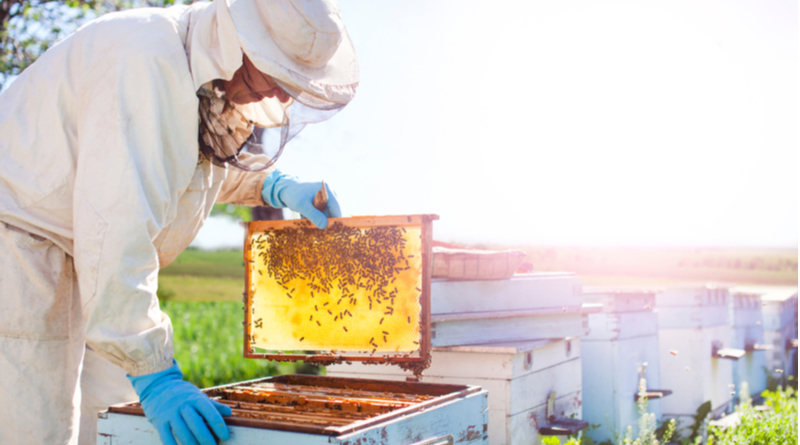What is Beekeeping?
Beekeeping is the practice of intentional maintenance of honeybee hives by humans. A beekeeper may keep bees to collect honey and beeswax, or pollinate crops, or produce bees for sale to other beekeepers. A location where bees are kept is called an apiary.
Beekeeping is an agriculture-based activity that is being undertaken by farmers/landless laborers in rural areas as an integrated farming practice. Beekeeping supplements income & employment generation and nutritional intake of the rural population.
The science and art of managing honey bees is called apiculture or beekeeping and is a centuries-old tradition.
What 3rd level courses are available?
Universities and colleges in Ireland are offering Beekeeping courses in the following subject areas:
- Beginners Beekeeping – Introduction to the art of beekeeping, the life cycle of bees, and caring for hives. Beekeeping provides huge benefits to the environment as well as that most nutritious and natural food, honey.
- Beekeeping – All you need to know about getting started in beekeeping such as managing bees, the life cycle of the colony, bee diseases, treatments, feeding, swarm control, and harvesting honey as a crop.
- Natural Beekeeping Diploma Course – The Natural Beekeeping Diploma Course introduces you to the practical application of environmentally responsible and bee-friendly beekeeping.
Studying Beekeeping in college
Many Beekeeping courses take place over 1 year to 4 years depending on the course and modules selected. There are also part-time courses and night courses available so you can be sure to fit in your studies no matter what your schedule is like.
Courses will cover theory work through lectures, assignments, tutorials, and taught modules. Assessments will take place continuously with written examinations and practical assignments combined to achieve a qualification. You could also consider work experience or a work shadow in the industry. Having practical experience will make you stand out and will demonstrate your passion for the industry.
Work Experience will not only allow you to obtain a deeper knowledge and understanding of the industry, but it will also give you a chance to do some essential networking with other industry professionals and gain valuable contacts for the future.
Career options
After completing a course in Beekeeping you will be able to get started in a career that uses specific knowledge of bees and apiculture.
As a new entrant to beekeeping, you can expect to begin as an assistant working alongside a more seasoned professional. With experience, you can progress to more responsibility and management and could eventually be responsible for completely overseeing various hives or start your own business or consultancy.
You may find employment with large estates, agricultural colleges, scientific research institutes, government departments for food regulations, large food-producing companies, smaller farms, fresh produce companies, and farm management companies.
Working hours will depend on whether you are employed by a company with set business hours or if you are contracted to various facilities or companies. The hours are usually full-time, but depending on your role and the season you may be on call day and night, seven days a week.
Related jobs include:
- Apiculturist
- Apiarist
- Beekeeper
- Agricultural consultant
- Estates manager
- Farm manager
- Plant breeder/geneticist
- Amenity horticulturist
- Commercial horticulturist
- Forest/woodland manager
- Horticultural consultant
- Magazine journalist
- Newspaper journalist
- Sales executive
Further study
After completing a course in Beekeeping you may choose to pursue further study in a specialist field to increase your knowledge base and skillset. Postgraduate study can also be used as a means to change career focus or to gain professional qualifications required to practice in certain career areas such as animal technology, agricultural science, and horticulture.
FAQ
What are manmade beehives called?
An apiary (also known as a bee yard) is a location where beehives of honey bees are kept. Apiaries come in many sizes and can be rural or urban depending on the honey production operation. Furthermore, an apiary may refer to a hobbyist’s hives or those used for commercial or educational usage
There are three main types of beehives in use today – the Langstroth, the Warre, and the Top Bar.
What types of bees are there in a hive?
The members of the hive are divided into three types:
· Queen: One queen runs the whole hive. Her job is to lay the eggs that will spawn the hive’s next generation of bees. The queen also produces chemicals that guide the behavior of the other bees.
· Workers: these are all female and their roles are to forage for food (pollen and nectar from flowers), build and protect the hive, clean and circulate air by beating their wings. Workers are the only bees most people ever see flying around outside the hive.
· Drones: These are the male bees, and their purpose is to mate with the new queen. Several hundred live in each hive during the spring and summer. But come winter, when the hive goes into survival mode, the drones are kicked out.
Where can I study Beekeeping?
Explore your options here
Did You Know?
· Honey bees are super-important pollinators for flowers, fruits, and vegetables. Bees transfer pollen between the male and female parts, allowing plants to grow seeds and fruit.
· Bees produce honey as food stores for the hive during winter. Luckily for us, these efficient little workers produce 2-3 times more honey than they need, so we get to enjoy the tasty treat, too.
· If the queen bee dies, workers will create a new queen by selecting a newly hatched young larva and feeding it a special food called “royal jelly“. This enables the larva to develop into a fertile queen.
· Honey bees fly at a speed of around 25km per hour and beat their wings 200 times per second.
· The average worker bee lives for just five to six weeks. During this time, she’ll produce around a twelfth of a teaspoon of honey.
· The queen can live up to five years. She is busiest in the summer months when she can lay up to 2,500 eggs a day.












Comments